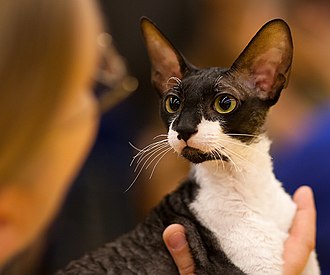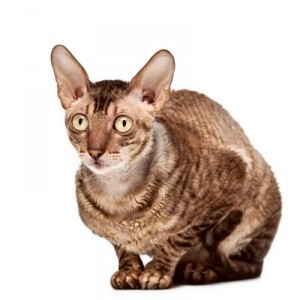 A Cornish Rex is a breed of domestic cat. The Cornish Rex has no hair except for down. Most breeds of cat have three different types of hair in their coats: the outer fur or “guard hairs”, a middle layer called the “awn hair”; and the down hair or undercoat, which is very fine and about 1 cm long. Cornish Rexes only have the undercoat. They are prone to hair loss and many will develop a very thin coat or even go bald over large parts of their body. The curl in their fur is caused by a different mutation and gene than that of the Devon Rex. The breed originated in Cornwall, Great Britain.
A Cornish Rex is a breed of domestic cat. The Cornish Rex has no hair except for down. Most breeds of cat have three different types of hair in their coats: the outer fur or “guard hairs”, a middle layer called the “awn hair”; and the down hair or undercoat, which is very fine and about 1 cm long. Cornish Rexes only have the undercoat. They are prone to hair loss and many will develop a very thin coat or even go bald over large parts of their body. The curl in their fur is caused by a different mutation and gene than that of the Devon Rex. The breed originated in Cornwall, Great Britain.
The Cornish Rex is an athletic cat and will maintain her ideal weight if provided with enough space for exercise. Thanks to the close-lying nature of the coat, you can easily tell if a Cornish is getting too heavy.
The Cornish Rex is agile and loves to jump, run, and play. When she is playing, she can appear to be inexhaustible. She should have interactive exercises as well. The Cornish Rex becomes involved with her parent. She loves to be right next to her parent and must have some time together every day. Many Cornish Rex will do anything to be with their parents and will even learn to walk on a lead in order to spend more time together. In general, they love being handled by their parents.
Here are some health issues your Cornish Rex is prone at:

- Arterial Thromboembolism
Cats with heart disease may develop blood clots in their arteries known as FATE (feline aortic thromboembolisms). Blood clots most commonly become lodged just past the aorta, the large blood vessel that supplies blood from the heart to the body, blocking normal blood flow to the hind legs. When this happens, one or both hind legs may become paralyzed, cold, or painful.
- Blood Type
Although we hate to think of the worst happening to our pets, when disaster strikes, it’s best to be prepared. One of the most effective life-saving treatments available in emergency medicine today is the use of blood transfusions. If your cat is ever critically ill or injured and in need of a blood transfusion, the quicker the procedure is started, the better the pet’s chance of survival.
- Patellar Luxation
The stifle, or knee joint, is a remarkable structure that allows a cat to perform amazing feats of agility like crouching, jumping, and pouncing. One of the main components of the stifle is the patella or kneecap, and the medical term luxation means “being out of place”. Thus, a luxating patella is a kneecap that slips off to the side of the leg because of an improperly developed stifle. A cat with a luxating patella may not show signs of pain or abnormality until the condition is well advanced; signs of this condition appear gradually and can progress to lameness as the cat grows older.
- Hypotrichosis
Hypotrichosis is caused by a recessive genetic defect found in several cat breeds, including Cornish Rexes. This disease causes thinning of the hair or balding, which tends to develop in patterns or patches on the torso and head. A kitten can be born with symmetrical hair loss, or thinning of hair may ensue shortly after birth. In time, affected areas may develop additional pigmentation or thickened skin.
Sources:
https://valleyanimalhospitalllc.com/client-resources/breed-info/cornish-rex/
Photo credit : https://en.wikipedia.org/wiki/Cornish_Rex

